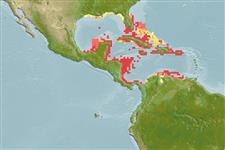Environment: milieu / climate zone / depth range / distribution range
Écologie
marin récifal; profondeur 0 - 9 m. Subtropical; 33°N - 25°S, 95°W - 65°W
Western Atlantic: Bermuda, southern Florida (USA), Bahamas, and Yucatan (Mexico) to the Antilles (Ref. 26340) and northern South America.
Taille / Poids / Âge
Maturity: Lm ? range ? - ? cm
Max length : 102 cm TL mâle / non sexé; (Ref. 7251)
Light brown to grayish brown, darker above, with pale spots (Ref. 26938).
Commonly encountered swimming near the bottom in clear water from harbors to reefs. More common along continent and in grassy areas (Ref. 7251). Found in shallow areas to depths of 9 m. Feeds mainly on crabs. (Ref. 26938).
Life cycle and mating behavior
Maturities | Reproduction | Spawnings | Egg(s) | Fecundities | Larves
Distinct pairing (Ref. 205).
Robins, C.R., R.M. Bailey, C.E. Bond, J.R. Brooker, E.A. Lachner, R.N. Lea and W.B. Scott, 1991. Common and scientific names of fishes from the United States and Canada. Am. Fish. Soc. Spec. Publ. (20):183 p. (Ref. 3814)
Statut dans la liste rouge de l'IUCN (Ref. 130435)
Menace pour l'homme
Harmless
Utilisations par l'homme
Outils
Articles particuliers
Télécharger en XML
Sources Internet
Estimates based on models
Preferred temperature (Ref.
123201): 26.1 - 28.3, mean 27.5 °C (based on 435 cells).
Phylogenetic diversity index (Ref.
82804): PD
50 = 0.5005 [Uniqueness, from 0.5 = low to 2.0 = high].
Bayesian length-weight: a=0.00089 (0.00039 - 0.00204), b=3.00 (2.80 - 3.20), in cm total length, based on LWR estimates for this (Sub)family-body shape (Ref.
93245).
Niveau trophique (Ref.
69278): 3.5 ±0.5 se; based on diet studies.
Résilience (Ref.
120179): Milieu, temps minimum de doublement de population : 1,4 à 4,4 années (Preliminary K or Fecundity.).
Fishing Vulnerability (Ref.
59153): High vulnerability (61 of 100).
Nutrients (Ref.
124155): Calcium = 22.6 [9.9, 50.3] mg/100g; Iron = 0.489 [0.252, 0.990] mg/100g; Protein = 19.6 [17.3, 22.1] %; Omega3 = 0.13 [0.05, 0.36] g/100g; Selenium = 15.6 [7.4, 38.2] μg/100g; VitaminA = 28.2 [7.1, 106.3] μg/100g; Zinc = 0.643 [0.414, 1.011] mg/100g (wet weight);
